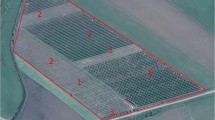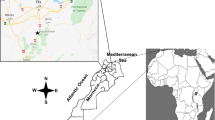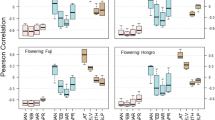Abstract
Apple phenology is greatly influenced by temperature. For quality apple production in the orchards, knowledge of the real timing of phenological stages is essential for scientific management decisions. In the Kashmir region, the year 2017 had a normal weather phenomenon, whereas the year 2018 had an erratic weather phenomenon wherein unusually high temperatures prevailed in the winter months and may be a clear sign of climate change effect. Due to this higher temperature in winter months of the year 2018 before bud break, earliness of phenological stages happened as compared to the year 2017, viz. silver tip stage by 5.67 days, green tip stage by 6.61 days, pink bud stage by 10.09 days, initial bloom by 10.43 days, full bloom by 9.70 days, and petal fall by 8.00 days. The flowering duration was overall recorded 2.43 days more in 2018 as compared to that in 2017. Due to the earliness of phenological stages in 2018, all twenty-five cultivars of the apple remained at high risk of spring frost and scientific apple orchard interventions were badly hit as growers were surprised and unprepared. The information generated will be very useful for growers, students, researchers, policy makers, and all the concerned stakeholders to understand how apple phenology responds to normal and extreme erratic weather conditions and may happen more frequently in the future due to climate change.







Similar content being viewed by others
References
Asghar A, Ali SM, Yasmin A (2012) Effect of climate change on apple (Malus domestica var. Ambri) production: A case study in Kotli Satian, Rawalpindi. Pakistan Pakistan Journal of Botany 44:913–1918
Beil I, Kreyling J, Meyer C, Lemcke N, Malyshev AV (2021) Late to bed, late to rise-warmer autumn temperatures delay spring phenology by delaying dormancy. Glob Change Biol 27:5806–5817. https://doi.org/10.1111/gcb.15858
Bozbuga F, Pirlak L (2012) Determination of phenological and pomological characteristics of some apple cultivars in Nigde-Turkey ecological conditions. J Anim Plant Sci 22:183–187
Campoy JA, Ruiz D, Egea J (2011) Dormancy in temperate fruit trees in a global warming context: a review. Sci Hortic 130(2):357–372
Campoy JA, Ruiz D, Allderman L, Cook N, Egea J (2018) The fulfilment of chilling requirements and the adaptation of apricot (Prunus armeniaca L.) in warm winter climates: an approach in Murcia (Spain) and the Western cape (South Africa). Eur J Agron 37(1):43–55
Chitu E, Paltineanu C (2020) Timing of phenological stages for apple and pear trees under climate change in a temperate-continental climate. Int J Biometeorol. https://doi.org/10.1007/s00484-020-01903-2
Dad JM, Muslim M, Rashid I, Reshi ZA (2021) Time series analysis of climate variability and trends in Kashmir Himalaya. Ecol Indic 126. https://doi.org/10.1016/j.ecolind.2021.107690.
Darbyshire R, Webb L, Goodwin I, Barlow EWR (2013) Impact of future warming on winter chilling in Australia. International Journal of Biometeorology 57:355–366
Dennis FJ (2003) Flowering, pollination and fruit set and development. In: Ferree DC (ed) Apples botany production and uses. CAB International, Cambridge, pp 153–166
Fraga H, Santos JA (2021) Assessment of climate change impacts on chilling and forcing for the main fresh fruit regions in Portugal. Frontiers in Plant Sciences 12:689121
Fu YH, Zhao H, Piao S, Peaucelle M, Peng S, Zhou G, Ciais P, Huang M, Menzel A, Peñuelas J, Song Y, Vitasse Y, Zeng Z, Janssens IA (2015) Declining global warming effects on the phenology of spring leaf unfolding. Nature 526:104–107
Gabaldon-Leal C, Ruiz-Ramos M, de la Rosa R, Leon L, Belaj A, Rodriguez A, Santos C, Lorite IJ (2017) Impact of changes in mean and extreme temperatures caused by climate change on olive flowering in southern Spain. Int J Climatol 37:940–957
Gujree I, Wani I, Muslim M, Farooq M, Meraj G (2017) Evaluating the variability and trends in extreme climate events in the Kashmir Valley using PRECIS RCM simulations. Model Earth Syst Environ 3:1647–1662
Gupta AK, Negi M, Nandy S, Alatalo JM, Singh V, Pandey R (2019) Assessing the vulnerability of socio-environmental systems to climate change along an altitude gradient in the Indian Himalayas. Ecological Indicators. 106:105512
Hauagge R, Cummins JN (1991) Phenotypic variation of length of bud dormancy in apple cultivars and related Malus species. J Am Soc Hortic Sci 116:100–106
Hirst PM, Ferree DC (1995) Rootstock effects on shoot morphology and spur quality of Delicious apple and relationships with precocity and productivity. J Am Soc Hortic Sci 120:622–634
IPCC (2018) Summary for policymakers. In: Masson-Delmotte V, Zhai P, Portner HO, Roberts D, Skea J, Shukla PR ... Waterfield T. (Eds.) Global warming of 1.5°C. An IPCC Special Report on the Impacts of Global Warming of 1.5°C above Pre-Industrial Levels and Related Global Greenhouse Gas Emission Pathways, in the Context of Strengthening the Global Response to the Threat of Climate Change, Sustainable Development, and Efforts to Eradicate Poverty. World Meteorological Organization, Geneva, Switzerland, pp. 32.
Lang GA, Early JD, Martin GC, Darnell RL (1987) Endodormancy, paradormancy, and ecodormancy-physiological terminology and classification for dormancy research. HortScience 22:371–377
Luedeling E (2012) Climate change impacts on winter chill for temperate fruit and nut production: a review. Sci Hortic 144:218–229
Luedeling E, Girvetz EH, Semenov MA, Brown PH (2011) Climate change affects winter chill for temperate fruit and nut trees. PLOS One 6(5):e20155
Martinez JJ, Gardea AA, Sagnelli S, Olivas J (1999) Sweet cherry adaptation to mild winters. Fruit Varieties Journal 53:181–183
Midgley SJE, Lotze E (2011) Climate change in the western cape of South Africa: trends, projections and implications for chill unit accumulation. Acta Hort 903:1127–1134
Morinaga K (2018) Food and Fertilizer Technology Center. Impact of climate change on horticulture industry and technological countermeasures in Japan. Retrieved from http://www.fftc.agnet.org/library.php?func=view&id=20120104150721.
Para JA, Kesarkar A, Bhate J, Singh V, Panchal A, Munsi A, Shivamurthy Y, Lotus S, Ahmad N, Sheikh JA (2020) Large-Scale dynamics of western disturbances caused extreme precipitation on 24–27 January 2017 over Jammu and Kashmir, India. Model Earth Syst Environ 6:99–107
Parkes H, Darbyshire R, White N (2020) Chilling requirements of apple cultivars grown in mild Australian winter conditions. Scientia Horticulturae 260:108858
Pfleiderer P, Menke I, Schleussner C (2019) Increasing risks of apple tree frost damage under climate change. Clim Change 157:515–525
Piao S, Liu Q, Chen A, Janssens IA, Fu Y, Dai J, Liu L, Lian X, Shen M, Zhu X (2019) Plant phenology and global climate change: current progresses and challenges. Glob Change Biol 25(6):1922–1940
Rafiq M, Mishra AK (2018) A study of heavy snowfall in Kashmir, India in January 2017. Weather 73:15–17
Ramírez F, Davenport TL (2013) Apple pollination: a review. Sci Hortic 162:188–203. https://doi.org/10.1016/j.scienta.2013.08.007
Rashid I, Romshoo SA, Chaturvedi RK, Ravindranath NH, Sukumar R, Jayaraman M, Lakshmi TV, Sharma J (2015) Projected climate change impacts on vegetation distribution over Kashmir Himalayas. Clim Change 132:601–613
Rashid I, Romshoo SA, Abdullah T (2017) The recent deglaciation of Kolahoi valley in Kashmir Himalaya, India in response to the changing climate. J Asian Earth Sci 138:38–50
Rashid I, Parray AA, Romshoo SA (2019) Evaluating the performance of remotely sensed precipitation estimates against in-situ observations during the September 2014 mega-flood in the Kashmir Valley. Asia Pac J Atmos Sci 55:209–219
Rivero R, Sønsteby A, Heide OM, Mage F, Remberg SF (2017) Flowering phenology and the interrelations between phenological stages in apple trees (Malus domestica Borkh.) as influenced by the Nordic climate. Acta Agriculturae Scandinavica, Section B-Soil & Plant Science 67(4):292–302. https://doi.org/10.1080/09064710.2016.1267256
Rodriguez AJ, Sherman (1985) Relationships between parental, seed, and seedling chilling requirement in peach and nectarine. J Am Soc Hortic Sci 110:627–630
Rohde A, Bhalerao RP (2007) Plant dormancy in the perennial context. Trends Plant Sci 12:217–223
Romshoo SA, Altaf S, Rashid I, Ahmad DR (2018) Climatic, geomorphic and anthropogenic drivers of the 2014 extreme flooding in the Jhelum basin of Kashmir, India. Geomat Nat Haz Risk 9:224–248
Sahu N, Saini A, Behera SK, Sayama T, Sahu L, Nguyen V, Takara K (2020) Why apple orchards are shifting to the higher altitudes of the Himalayas? PLOS ONE 15(7):e0235041
Schwartz MD (1999) Advancing to full bloom: planning phenological research for the 21st century. Int J Biometeorol 42:13–118
Singh N, Sharma D, Chand H (2016) Impact of climate change on apple production in India: a review. Curr World Environ 11(1):251
Sorensen FC (1983) Relationship between logarithms of chilling period and germination or bud flush rate is linear for many tree species. Forest Science 29:237–240
Sugiura T, Ogawa H, Fukuda N, Moriguchi T (2013) Changes in the taste and textural attributes of apples in response to climate change. Sci Rep 3:2418. https://doi.org/10.1038/srep02418
Villalpando J, Ruiz A (1993) Observaciones Agrometeorolo´gicas y su uso en la Agricultura. Editorial Lumusa, Mexico, 133
Volpe CA (1992) Citrus phenology. In: Proceedings of the Second International Seminar on Citrus Physiology. 103–122
Wang SL, Ball E, Nehring R, Williams R, Chau T (2017) Impacts of climate change and extreme weather on US agricultural productivity: Evidence and Projection. Working Paper 23533. https://doi.org/10.3386/w23533
Yaacoubi AE, Malagi G, Oukabli A, Hafidi M, Legave J (2014) Global warming impact on floral phenology of fruit trees species in Mediterranean region. Sci Hortic 180:243–253
Yaacoubi AE, Jaouhari NE, Bourioug M, Youssfi LE, Cherroud S, Bouabid R, Chaoui M, Abouabdillah A (2019) Potential vulnerability of Moroccan apple orchard to climate change–induced phenological perturbations: effects on yields and fruit quality. Int J Biometeorol. https://doi.org/10.1007/s00484-019-01821-y
Yu D, Liu Y, Shi P, Wu J (2019) Projecting impacts of climate change on global terrestrial ecoregions. Ecol Ind 103:114–123
Zaz SN, Romshoo SA, Krishnamoorthy RT, Viswanadhapalli Y (2019) Analyses of temperature and precipitation in the Indian Jammu and Kashmir region for the 1980–2016 period: implications for remote influence and extreme events. Atmos Chem Phys 19:15–37
Acknowledgements
The authors thank SKUAST-K Fruit Science Department’s head for providing necessary facilities for this research programme. Thanks are also due to AMFU-SKUAST-K for providing meteorological data during the years of study.
Author information
Authors and Affiliations
Contributions
M.T. Ali: investigation, writing – original draft; writing – review and editing, project administration; M.S. Mir: conceptualization, methodology; S. Mehraj: resources, validation; I.A. Shah: software, formal analysis.
Corresponding author
Ethics declarations
Competing interests
The authors declare no competing interests.
Ethics approval and consent to participate
We all declare that manuscripts reporting studies do not involve any human participants, human data, or human tissue. So it is not applicable.
Consent for publication
Our manuscript does not contain data from any individual person, so it is “not applicable.”
Supplementary Information
Below is the link to the electronic supplementary material.
Rights and permissions
About this article
Cite this article
Ali, M.T., Mir, M.S., Mehraj, S. et al. Implications of variable environments on phenology of apple (Malus × domestica Borkh.) in Northwestern Himalayan region. Int J Biometeorol 66, 945–956 (2022). https://doi.org/10.1007/s00484-022-02250-0
Received:
Revised:
Accepted:
Published:
Issue Date:
DOI: https://doi.org/10.1007/s00484-022-02250-0




